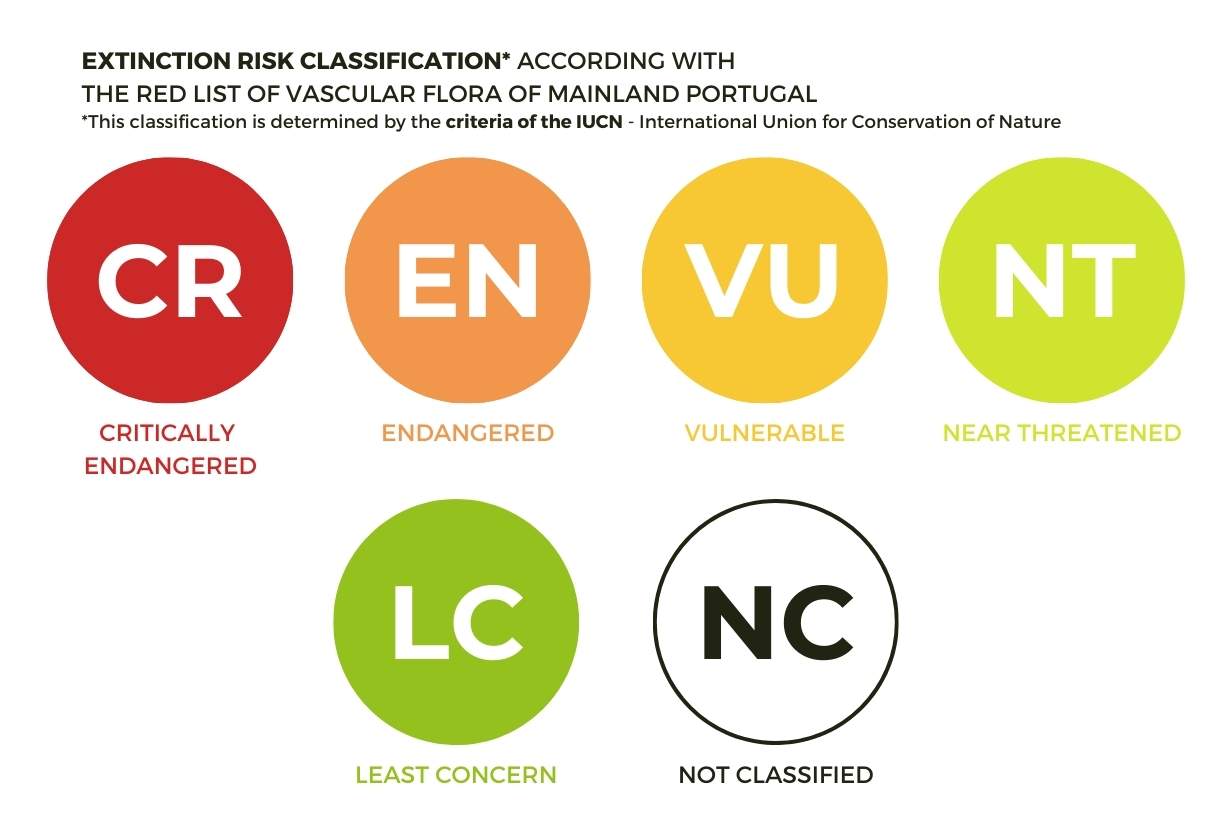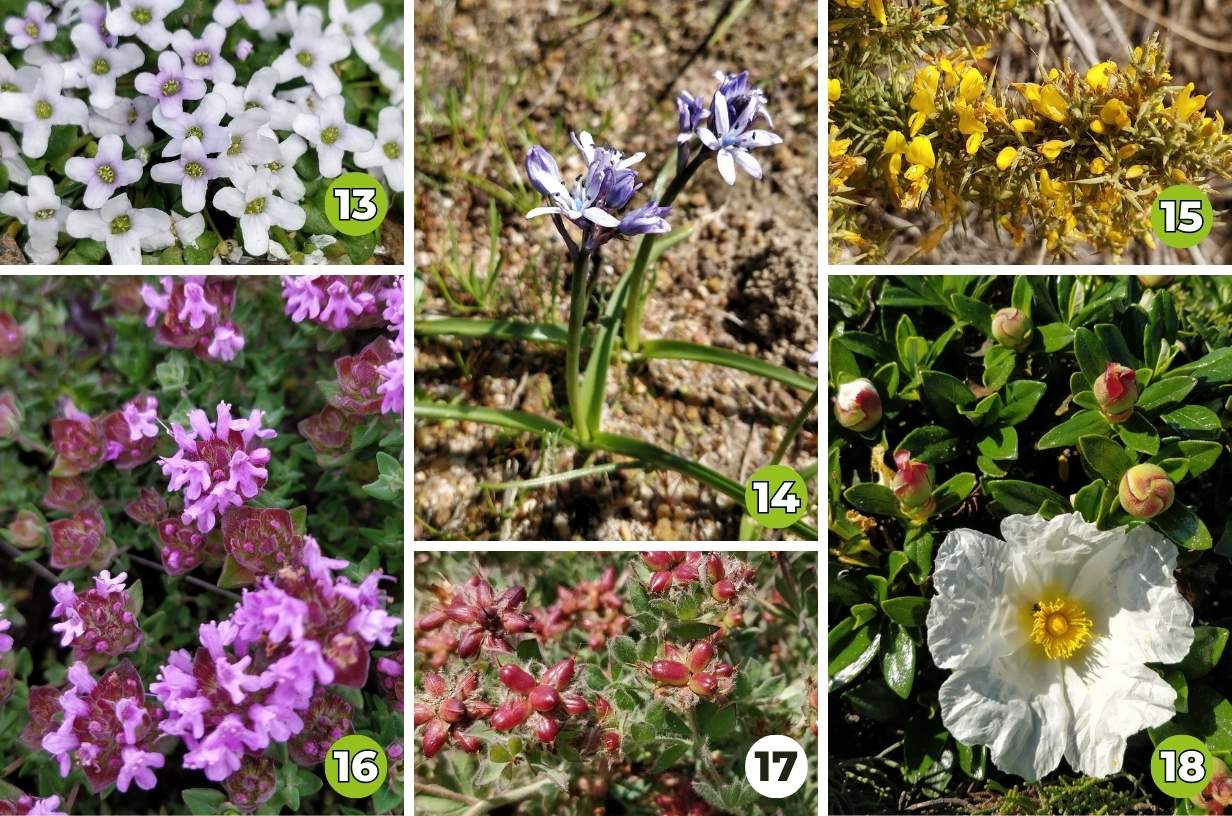Endemic, rare, and threatened Flora of Rota Vicentina
6 reading timeFlora biodiversity in the Southwest of Portugal
Alentejo and Vicentina Coast Natural Park (PNSACV) is a nationally and internationally recognized biodiversity hotspot due to its diverse landscapes and ecosystems.
Located in the southwestern part of the European continent, this territory is delimited by a continuous chain of mountains (from the Serra do Cercal to the Serra de Monchique).
This refuge condition, where numerous species survived during the last glaciation, has contributed to the presence of a large number of endemic, rare, and threatened species, some of which are found exclusively in this coastal strip.
During volunteer activities on Rota Vicentina Walking Trails, numerous species classified as RELAPE* (Rare, Endemic, Localized, Threatened, or Endangered Plants) have been mapped.
The presence of these plants attests to the importance of preserving these priority ecosystems of great natural value.

Through the records of the Flora-on** platform, we have been able to identify a total of 53 species classified as threatened in this territory, encompassing the categories*** of Vulnerable, Endangered, and Critically Endangered.

*RELAPE species is a designation used to refer to all rare, endemic, localized, threatened, or endangered plant species. This platform is constantly updated and serves, among other things, as a practical way to identify plant species of Portuguese flora.
**Flora-on - an online platform launched in 2012, created by the Portuguese Society of Botany, where photographic, geographic, morphological, and ecological information of native or naturalized plant species in mainland Portugal, Azores, and Madeira is systematized. This platform is constantly updated and serves, among other things, as a practical way to identify plant species of Portuguese flora.
*** Categories of extinction risk - defined by the International Union for Conservation of Nature (IUCN) based on precise criteria that serve as a reference for all countries, allowing for a technical and reliable assessment of species conservation status and the production of highly detailed inventories, known as "Red Lists".
On Walking Trails of Rota Vicentina
During volunteering activities, trail maintenance and field visits, the team from Rota Vicentina Association and its volunteers have already recorded at least 12 of these species, even without actively searching for them.
This territory is very vast, and we can find more “typical” species for each trail.
In the case of the Fishermen’s Trail, which mostly follows the coastline, we can find the presence of species such as:
- Southern boxthorn – Lycium intricatum (photo 1)
- Joint-pine – Ephedra fragilis (photo 2)
- Autumn mandrake – Mandragora autumnalis (photo 3)
- Goat’s thorn milkvetch – Astragalus tragacantha (photo 4)
- Ulex erinaceus (photo 5)
- Grizandra-vicentina – Diplotaxis siifolia subsp. vicentina (no photo)

In the Historical Way and Circular Routes, which are more inland and have higher temperatures, sun exposure, and dryness, we can find interesting species that are more adapted to these conditions, such as:
- Scorzonera baetica (photo 6)
- Dewy Pine – Drosophyllum lusitanicum (photo 7)
- Serrátula-do-algarve– Klasea algarbiensis (no photo)
In this extensive territory, it is also possible to find more humid and fresh ecosystems. It is in situations of fresh and shaded forest that it’s possible to find species such as:
- Leiteira-de-monchique – Euphorbia paniculata subsp. monchiquensis (photo 8)
- Monchique bellflower –– Campanula alata (no photo)
- or even the Algerian oak – Quercus canariensis (no photo), classified as “critically endangered,” whose conservation status is highly concerning.

Also at risk of extinction, but classified as “near-threatened” in the Red List of Vascular Flora of Continental Portugal, we have already found at least 8 different species out of the 28 recorded for this territory. Among these, we highlight 4 species that can be found in Alteirinhos’ Junipers pilot area:
- Sea-sand juniper – Juniperus navicularis (photo 12)
- Vicentine carrot – Daucus carota subsp. halophilus (photo 10)
- Biscutela-vicentina – Biscutella sempervirens subsp. vicentina (photo 9)
- White rockrose – Helianthemum apenninum subsp. stoechadifolium (photo 11)

Of the species that evolved and remained here, 45 are endemic to Portugal in the Southwest Alentejo and Vicentina Coast Natural Park (PNSACV).
At least 20 of these species have been sighted on Walking Trails of Rota Vicentina. The diversity is enormous! We can find plants of small dimensions that are difficult to identify, such as:
- Hérniária-marinha – Herniaria maritima (no photo)
- False diamondflower – Jonopsidium acaule (photo 13)
- Leiteira-do-sudoeste – Euphorbia transtagana (no photo)
- Ansarina-do-sudoeste – Linaria bipunctata subsp. glutinosa (no photo)
- Vicentine Bluebell – Hyacinthoides vicentina (photo 14).
Or larger plants with a thorny appearance that are nitrogen fixers, such as:
- Tojo-prateado – Ulex argenteus (photo 15);
- Ulex australis subsp. welwitschianus (no photo)
- Codeço-de-monchi que – Adenocarpus anisochilus (no photo).
It is also possible to find plants with attractive fragrances that accompany us for long distances:
- Vicentine Germander – Teucrium vicentinum (no photo)
- Camphor Thyme – Thymus camphoratus (photo 16)
- Thymus villosus (no photo)
- Dittrichia viscosa subsp. revoluta (no photo)
- Sagres Rockrose – Cistus ladanifer subsp. sulcatus (photo 18)
The diversity of flora is truly incredible, and even among species that are not threatened or endemic, we find examples of rare species. In Portugal, and almost exclusively in this coastal landscape, species such as the Hairy canary clover – Dorycnium hirsutum (photo 17) – and the Coastal Dwarf Ferula – Cachrys libanotis (no photo) stand out.

How to help protect the biodiversity of Rota Vicentina trails?
One of our commitments is to value and preserve the native flora on the trails and pilot areas of Rota Vicentina and to contribute to the mapping of this biodiversity.
By knowing its location, we will be able to easily raise awareness among hikers and partners about its importance.
For the preservation of these species, it is essential that hikers on Rota Vicentina’s Trails, more than knowing, help contribute to their protection of these species and ecosystems.
In this sense, we reinforce the importance of always staying on the trail marked with the Rota Vicentina signs, avoiding the proliferation of trails that accelerate habitat fragmentation and cause ecosystem degradation.
Did you find any of these species during your hike, or on your land? Do you want to contribute to the mapping of flora and fauna in this territory?
Click here to find out how
Graduated in Landscape Architecture, she has always been connected to Nature. Leonor loves plants, music, crafts, drawing and walking. The Alentejo is your home.

